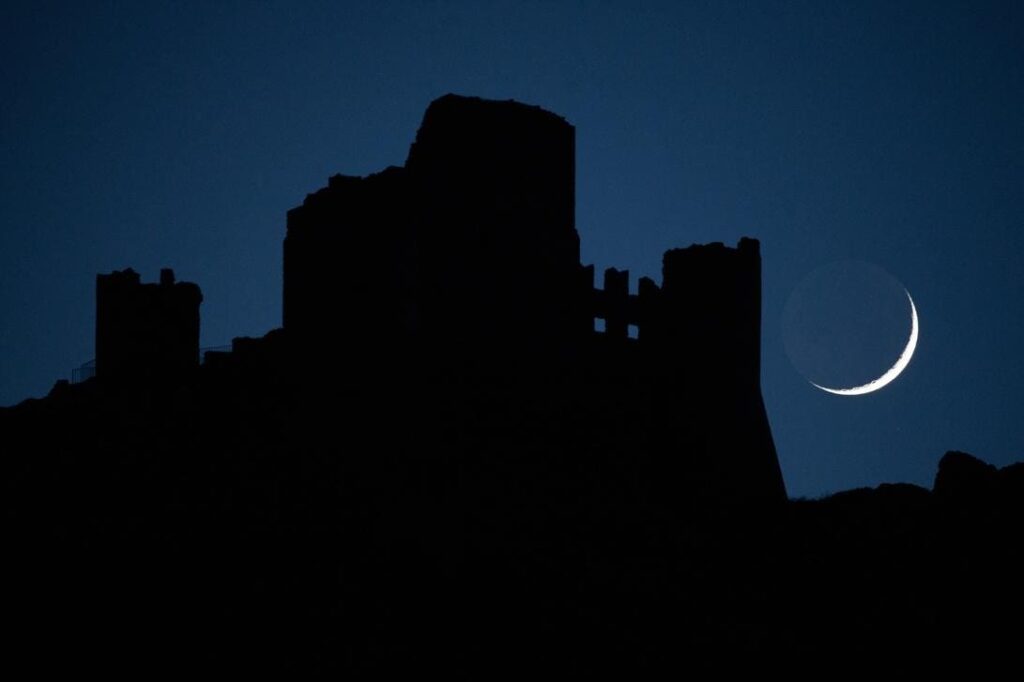A 7.4% crescent moon (earthshine) is seen next to Rocca Calascio castle in Calascio, Italy, on … [+] January 13th, 2024. (Photo by Lorenzo Di Cola/NurPhoto via Getty Images)
NurPhoto via Getty Images
Each Monday, I pick out North America’s celestial highlights for the week ahead (which also apply to mid-northern latitudes in the northern hemisphere), but be sure to check my main feed for more in-depth articles on stargazing, astronomy, eclipses and more.
The Night Sky This Week: June 10-16, 2024
Stargazers should make the most of this week. Next week, the solstice and a full moon combine, so true darkness will be hard to find north of the equator. So enjoy some post-sunset views of the crescent moon and take some time to pick out a new constellation of two. Here’s what’s happening in the night sky this week:
Monday, June 10: Waxing Crescent Moon
SkySafari (skysafariastronomy.com)
Monday, June 10: Waxing Crescent Moon
Look west after sunset for a 21% lit waxing crescent moon. Its dark limb will display “Earthshine”—sunlight reflected from our planet’s oceans and ice caps onto the lunar surface. It’s just strong enough to illuminate the moon’s limb subtly.
Tuesday, June 11: Waxing Crescent Moon And Regulus
SkySafari (skysafariastronomy.com)
Tuesday, June 11: Waxing Crescent Moon And Regulus
Each month, the moon can pass close to four bright stars. Tonight, it’s the turn of Regulus, the brightest star in Leo, which a 30% lit waxing crescent moon will visit. Look high above west.
Friday, June 14: First Quarter Moon
Universal Images Group via Getty Images
Friday, June 14: First Quarter Moon
Tonight is the first quarter moon, which is the time of the month when the moon appears half-lit as seen from Earth. It’s also when the night skies begin to get brightly lit by moonlight and stars become harder to see. Don’t plan a stargazing trip to a dark sky this week or next—you’ll get no benefit.
This image from the NASA/ESA Hubble Space Telescope shows NGC 6388, a dynamically middle-aged … [+] globular cluster in the Milky Way.
NASA, ESA, F. Ferraro (Universit
Saturday, June 15: NGC 6388
A globular cluster is a tight cluster of thousands to millions of stars in the Milky Way’s outskirts, considered relics of the early universe. According to In-The-Sky.org, the 10 billion-year-old NGC 6388 globular cluster will reach its highest in the sky of the year at midnight tonight in the constellation Scorpius. You’ll need a small telescope to view it, but don’t expect to see what the Hubble Space Telescope saw in 2012.
Sunday, June 16: Moon And Spica
SkySafari (skysafariastronomy.com)
Sunday, June 16: Moon And Spica
Tonight, the 76% lit waxing gibbous moon will be about a degree from Spica, the brightest star in the constellation of Virgo and about 250 light-years distant. The moon will be in close conjunction with Spica every month in 2024—but this one is the nearest. From Central Asia, the moon will appear to occult (eclipse) Spica for a few hours.
Corona Borealis constellation.
getty
Naked-Eye Target Of The Week: Corona Borealis Constellation
Have you ever seen the “Northern Crown?” Corona Borealis is a constellation of seven sparkling stars between Boötes and Hercules. Besides it being perfectly placed in June, there’s another good reason why you should make yourself familiar with this semi-circle crescent of stars—a “nova” is about to go off within it! Corona Borealis situated between bright summer stars Vega in the northeast and orangey Arcturus above.
M57 (NGC 6720), the famous Ring nebula in Lyra. The ring is an almost spherical, expanding gaseous … [+] shell around the central star. (Photo by © CORBIS/Corbis via Getty Images)
Corbis via Getty Images
Telescope Target Of The Week: The Ring Nebula
Recently captured in exquisite detail by the James Webb Space Telescope, this bright and colorful planetary nebula—the remnants of a star that went supernova—is easier if you’re away from light pollution. Either way, you’ll need a six-inch telescope. It’s around 2,000 light-years away in the constellation Lyra.
The times and dates given apply to mid-northern latitudes. For the most accurate location-specific information, consult online planetariums like Stellarium and The Sky Live. Check planet-rise/planet-set, sunrise/sunset and moonrise/moonset times for where you are.
Follow me on Twitter/X and Instagram.
Pick up my books Stargazing in 2024, A Stargazing Program For Beginners and When Is The Next Eclipse?
Wishing you clear skies and wide eyes.
>>> Read full article>>>
Copyright for syndicated content belongs to the linked Source : Forbes – https://www.forbes.com/sites/jamiecartereurope/2024/06/10/see-a-crescent-moon-after-sunset-the-night-sky-this-week
